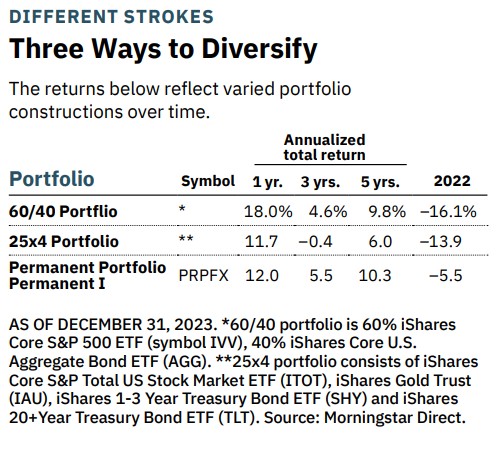Should You Use a 25x4 Portfolio Allocation?
The 25x4 portfolio is supposed to be the new 60/40. Should you bite?


After a disastrous market in 2022, many strategists claimed that the 60/40 portfolio, which holds 60% of assets in stocks and 40% in bonds, was dead. In its place, some strategists suggested investors consider the 25/25/25/25 portfolio, or 25x4 portfolio, which calls for dividing your assets evenly into stocks, bonds, commodities and cash.
"We believe the 25/25/25/25 portfolio will outperform the 60/40 portfolio in the 2020s," says Michael Hartnett, a chief investment strategist at BofA Global Research.
The simplest reason is that interest rates and inflation are higher than in decades past. The 60/40 portfolio worked best when inflation and interest rates were low or falling, says Hartnett. But this decade he expects higher inflation and interest rates, with added volatility, creating market conditions that are well suited for cash and commodities to outperform bonds and stocks.

Sign up for Kiplinger’s Free E-Newsletters
Profit and prosper with the best of expert advice on investing, taxes, retirement, personal finance and more - straight to your e-mail.
Profit and prosper with the best of expert advice - straight to your e-mail.
So far, though, that hasn't played out. Although the 25x4 portfolio did marginally better than a 60/40 portfolio in 2022, over longer periods, it has lagged. A 60/40 portfolio has gained 4.6% annualized over the past three years; a 25x4 portfolio has lost 0.4% on average per year.
Think twice before switching to the 25x4 portfolio
In short, don't count the 60/40 portfolio out yet. "Over the years, the 60/40 portfolio has held up for investors, and it's actually provided wonderful returns with low risk levels," says Jan Holman, director of adviser education at Thornburg Investment Management.
This isn't the first go-around for the 25x4 portfolio. It got its start decades ago by way of Harry Browne, the late investment adviser and two-time Libertarian Party presidential candidate (in 1996 and 2000). In Browne's so-called Permanent Portfolio strategy, investors held 25% in cash, 25% in gold, 25% in long-term bonds and 25% in stocks, rebalancing annually. The idea was that the four asset classes would help minimize risk no matter the market or economic condition.
Browne helped develop a no-load mutual fund tied to the 25x4 strategy called the Permanent Portfolio Permanent (PRPFX), which launched in 1982. But it's not a straight-up version of his approach. Instead, the fund is more "dynamic," says fund manager Michael Cuggino.
It targets an allocation of 30% stocks, 25% precious metals (20% in gold and 5% in silver) and 45% in bonds and cash (10% of which is denominated in Swiss Francs). The stock side of the portfolio includes a mix of real estate and natural-resources stocks, such as Prologis (PLD) and Exxon Mobil (XOM), as well as aggressive growth stocks, such as Nvidia (NVDA) and Meta Platforms (META). "The fund's goal is to outpace inflation," says Cuggino, a fund manager since 2003.
The fund's annualized 5.7% return over the past decade has indeed beaten the 2% average inflation rate over the period. And it has been far less volatile over that time than its peers (moderate allocation funds), which typically hold about 60% of assets in stocks. But 63% of its peers did better, generating an average 6.1% annualized 10-year return.
That's evidence that it's important to think through any allocation strategy carefully before you implement it. "Asset allocation should always be decided on an individual basis and in the context of a comprehensive financial plan, not based on a gimmick," says Gordon Achtermann, a certified financial planner in Fairfax, Virginia. As an alternative, consider a low-cost target-date fund. "You won't beat the market," he says, "but you won't get badly hurt, either."

Note: This item first appeared in Kiplinger's Personal Finance Magazine, a monthly, trustworthy source of advice and guidance. Subscribe to help you make more money and keep more of the money you make here.
Related content
Get Kiplinger Today newsletter — free
Profit and prosper with the best of Kiplinger's advice on investing, taxes, retirement, personal finance and much more. Delivered daily. Enter your email in the box and click Sign Me Up.

Nellie joined Kiplinger in August 2011 after a seven-year stint in Hong Kong. There, she worked for the Wall Street Journal Asia, where as lifestyle editor, she launched and edited Scene Asia, an online guide to food, wine, entertainment and the arts in Asia. Prior to that, she was an editor at Weekend Journal, the Friday lifestyle section of the Wall Street Journal Asia. Kiplinger isn't Nellie's first foray into personal finance: She has also worked at SmartMoney (rising from fact-checker to senior writer), and she was a senior editor at Money.
-
 Trump’s Tax Cut Risks Your SNAP, Medicaid Benefits
Trump’s Tax Cut Risks Your SNAP, Medicaid BenefitsTax Cuts The GOP budget blueprint could slash lifesaving programs for millions of U.S. households.
By Gabriella Cruz-Martínez
-
 Can Trump Fire Powell? A Supreme Court Case Could Decide
Can Trump Fire Powell? A Supreme Court Case Could DecidePresidential posts threaten to overwhelm decades of precedent and tradition, whatever the nine justices decide.
By David Dittman
-
 Why You Need a Trusted Contact for Your Brokerage
Why You Need a Trusted Contact for Your BrokerageYour brokerage or bank needs someone to reach out to if it's concerned you're experiencing fraud or cognitive decline. That's where a trusted contact can help.
By John Waggoner
-
 Stock Market Today: Dow Drops 699 Points After Powell Speech
Stock Market Today: Dow Drops 699 Points After Powell SpeechFed Chair Powell warned of a slowing economy and higher inflation but said the central bank isn't ready to cut rates just yet.
By Karee Venema
-
 Stock Market Today: Dow Drops Another 2,231 Points to Hit a Correction
Stock Market Today: Dow Drops Another 2,231 Points to Hit a CorrectionThe Nasdaq Composite, meanwhile, entered a new bear market with its latest slide.
By Karee Venema
-
 Stock Market Today: Dow Dives 1,679 Points on Trump Tariff Shock
Stock Market Today: Dow Dives 1,679 Points on Trump Tariff ShockU.S. stocks lost roughly $3.1 trillion in market cap on Thursday – the biggest one-day decline since the start of the COVID-19 pandemic in March 2020.
By Karee Venema
-
 The Stock Market Is Selling Off. Here's What Investors Should Do
The Stock Market Is Selling Off. Here's What Investors Should DoInvestors started fleeing the equities market en masse in response to the Trump administration's "jaw-dropping" tariffs. But the experts say don't panic.
By Karee Venema
-
 Stock Market Today: It's the Old Up-Down Again on Liberation Day
Stock Market Today: It's the Old Up-Down Again on Liberation DayMarkets look forward to what comes with the reordering of 80-year-old global trade relationships.
By David Dittman
-
 Can a New Manager Cure Vanguard Health Care Fund?
Can a New Manager Cure Vanguard Health Care Fund?Vanguard Health Care Fund has assets of $40.5 billion but has been ailing in recent years. With a new manager in charge, what's the prognosis?
By Nellie S. Huang
-
 Stock Market Today: Dow Rises 854 Points From Its Intraday Low
Stock Market Today: Dow Rises 854 Points From Its Intraday LowIf there's one thing markets hate, it's uncertainty. But uncertainty is all they're getting these days.
By David Dittman